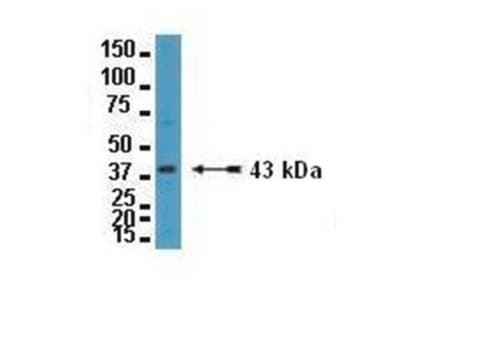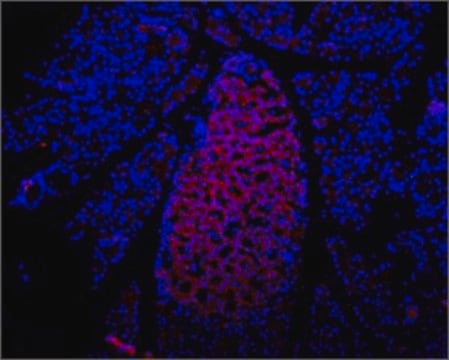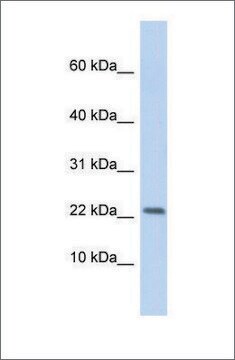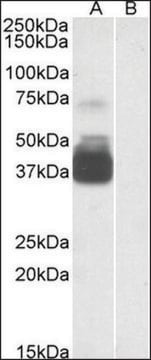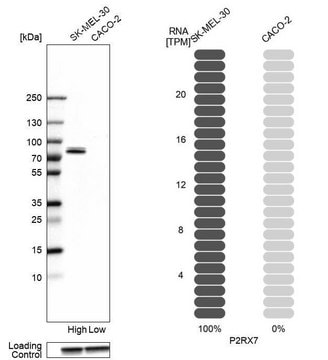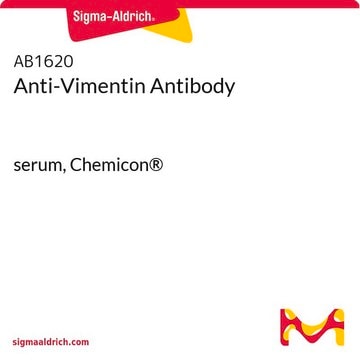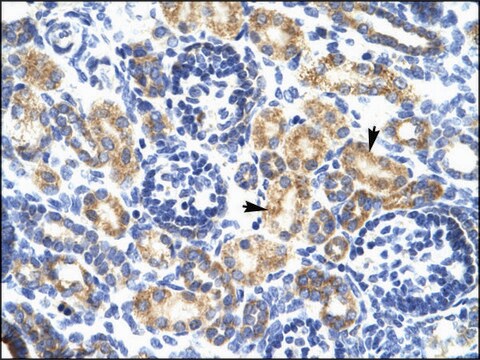AB5581
Anti-P2X7 Receptor Antibody, extracellular domain
Chemicon®, from rabbit
Sign Into View Organizational & Contract Pricing
All Photos(1)
About This Item
UNSPSC Code:
12352203
eCl@ss:
32160702
NACRES:
NA.41
Recommended Products
biological source
rabbit
Quality Level
antibody form
affinity purified immunoglobulin
antibody product type
primary antibodies
clone
polyclonal
purified by
affinity chromatography
species reactivity
rat, human
manufacturer/tradename
Chemicon®
technique(s)
western blot: suitable
NCBI accession no.
UniProt accession no.
shipped in
wet ice
target post-translational modification
unmodified
Gene Information
human ... P2RX7(5027)
Specificity
Recognizes P2X7, extracellular domain.
Immunogen
Epitope: extracellular domain
Highly purified peptide corresponding to residues 136-152 of mouse P2X7 (Accession Q9Z1M0).
Application
Anti-P2X7 Receptor Antibody, extracellular domain is an antibody against P2X7 Receptor for use in WB.
Research Category
Neuroscience
Neuroscience
Research Sub Category
Neurotransmitters & Receptors
Neurotransmitters & Receptors
Western blotting: 1:200 using ECL on rat brain membranes.
Flow cytometry, indirect: 5-10 μg antibody per 1x10E6 cells.
Dilutions should be made using a carrier protein such as BSA (1-3%).
Optimal working dilutions must be determined by the end user.
Flow cytometry, indirect: 5-10 μg antibody per 1x10E6 cells.
Dilutions should be made using a carrier protein such as BSA (1-3%).
Optimal working dilutions must be determined by the end user.
Physical form
Affinity purified immunoglobulin. Lyophilized from PBS, pH 7.4, containing 1% BSA and 0.05% sodium azide. Reconstitute with 200 μL of sterile distilled water. Centrifuge antibody preparation before use (10,000 x g for 5 min).
Storage and Stability
Maintain lyophilized material at -20°C for up to 6 months after date of receipt. After reconstitution maintain antibody and control peptide at -20°C in undiluted aliquots for up to 6 months. Avoid repeated freeze/thaw cycles.
Analysis Note
Control
Included free of charge with the antibody is 40 μg of control antigen (lyophilized powder). For negative control, preincubate 1 μg of purified peptide with 1 μg of antibody for one hour at room temperature. Optimal concentrations must be determined by the end user.
Included free of charge with the antibody is 40 μg of control antigen (lyophilized powder). For negative control, preincubate 1 μg of purified peptide with 1 μg of antibody for one hour at room temperature. Optimal concentrations must be determined by the end user.
Other Notes
Concentration: Please refer to the Certificate of Analysis for the lot-specific concentration.
Legal Information
CHEMICON is a registered trademark of Merck KGaA, Darmstadt, Germany
Disclaimer
Unless otherwise stated in our catalog or other company documentation accompanying the product(s), our products are intended for research use only and are not to be used for any other purpose, which includes but is not limited to, unauthorized commercial uses, in vitro diagnostic uses, ex vivo or in vivo therapeutic uses or any type of consumption or application to humans or animals.
Not finding the right product?
Try our Product Selector Tool.
Hazard Statements
Precautionary Statements
Hazard Classifications
Aquatic Chronic 3
Storage Class Code
11 - Combustible Solids
WGK
WGK 3
Certificates of Analysis (COA)
Search for Certificates of Analysis (COA) by entering the products Lot/Batch Number. Lot and Batch Numbers can be found on a product’s label following the words ‘Lot’ or ‘Batch’.
Already Own This Product?
Find documentation for the products that you have recently purchased in the Document Library.
Maria Lombardi et al.
Scientific reports, 7(1), 4872-4872 (2017-07-09)
In atherosclerosis, matrix metallopeptidases (MMPs) contribute to plaque rupture through weakening of the fibrous cap. Pleiotropic P2X purinoceptor 7 (P2X7), expressed in the carotid plaque (PL), is involved in interleukin 1 beta (IL-1β) release that may influence MMP9 generation, thus
Thomas Hansen et al.
American journal of physiology. Heart and circulatory physiology, 319(1), H183-H191 (2020-05-30)
In pulmonary hypertension (PH) a proinflammatory milieu drives pulmonary vascular remodeling, maladaptive right ventricular (RV) remodeling, and right-sided heart failure. There is an unmet need for RV-targeted pharmaco-therapies to improve mortality. Targeting of the P2X7 receptor (P2X7R) reduces pulmonary pressures;
Our team of scientists has experience in all areas of research including Life Science, Material Science, Chemical Synthesis, Chromatography, Analytical and many others.
Contact Technical Service
